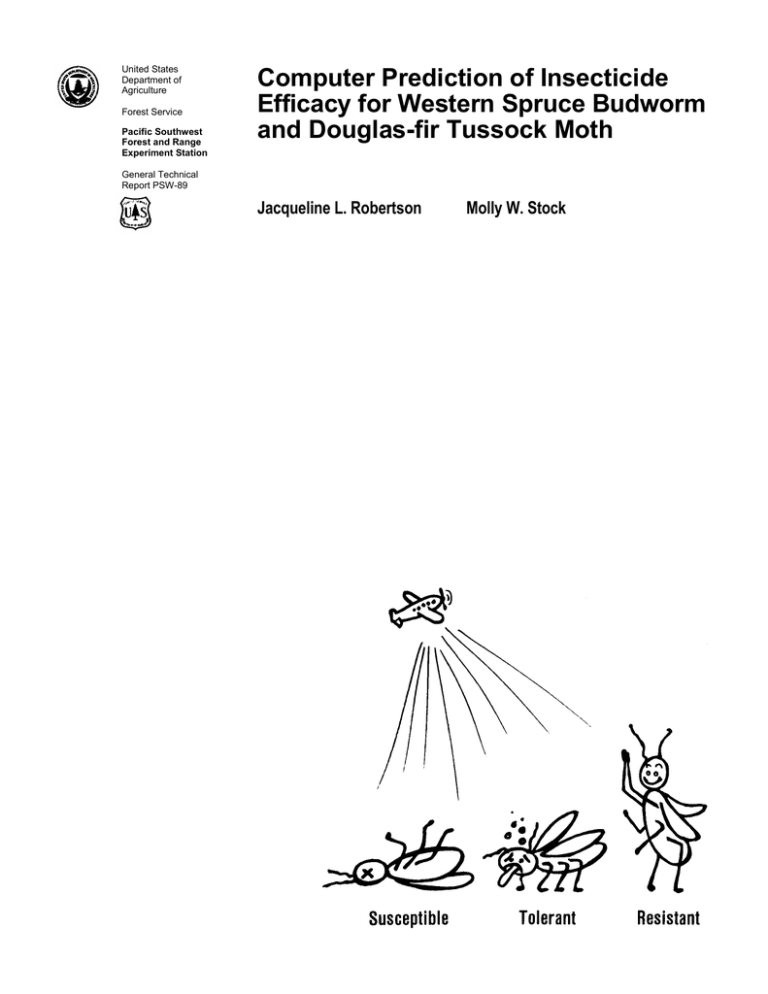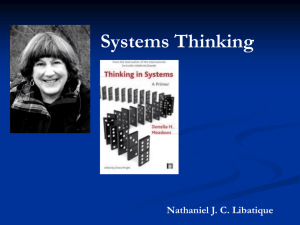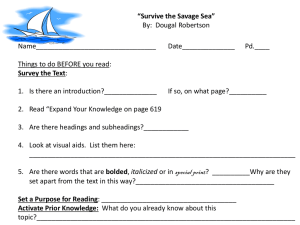Document 11236070
advertisement

United States Department of Agriculture Forest Service Pacific Southwest Forest and Range Experiment Station Computer Prediction of Insecticide Efficacy for Western Spruce Budworm and Douglas-fir Tussock Moth General Technical Report PSW-89 Jacqueline L. Robertson Molly W. Stock The Authors: JACQUELINE L. ROBERTSON, a research entomologist, heads the Station's Forest Insect Management Research Unit, at Berkeley. She earned a doctorate in entomology (1973) at the University of California, Berkeley. She has been a member of the Station's research staff since 1966. MOLLY W. STOCK is a Professor in the Department of Forestry, Wildlife, and Range Sciences, University of Idaho, Moscow. She earned a doctorate in entomology (1972) at Oregon State University, Corvallis. Acknowledgments: We thank Jo Ellen Force, University of Idaho, Moscow; Robert W. Campbell, Forest Service, Corvallis, Oregon; Carroll B. Williams, Forest Service, Berkeley, California; and Michael Saunders, Texas A&M University, College Station, for their helpful reviews of this manuscript. Michael Shook, Washington State University, Pullman, provided valuable assistance with the graphics of the computer program developed in the study reported herein. Publisher: Pacific Southwest Forest and Range Experiment Station PO. Box 245, Berkeley, California 94701 April 1986 Computer Prediction of Insecticide Efficacy for Western Spruce Budworm and Douglas-fir Tussock Moth Jacqueline L. Robertson Molly W. Stock CONTENTS Introduction .............................................................................................. 1 1. Mathematical Procedures .................................................................... 1 2. Program ................................................................................................. 2 2.1 Insect ................................................................................................. 2 2.2 Genetic Predisposition of Population ................................................ 2 2.3 Insecticide ......................................................................................... 3 2.4 Application Rate Per Unit Area ........................................................ 3 3. Program Options .................................................................................. 3 3.1 Option A ........................................................................................... 3 3.2 Option B ............................................................................................ 3 3.3 Option C ............................................................................................ 3 3.4 Option D ............................................................................................ 6 4. Discussion .............................................................................................. 6 5. Appendix: Program Listing ................................................................. 7 6. References ........................................................................................... 11 i INTRODUCTION B ecause laboratory experiments are relatively inexpensive compared to field trials, many attempts have been made to use laboratory data to estimate the results of applying insecticides to populations of a target forest defoliator. Predictions based on well-designed laboratory tests and validated by field tests can help ensure that the desired insect mortality is attained with minimum cost. Early laboratory studies emphasized screening of candidate insecticides by topical application (e.g., Robertson and Lyon 1973; Robertson and others 1975, 1976). By comparing the relative contact toxicities of new candidates to the toxicities of insecticides already field-tested, crude extrapolations were made to suggest field application rates for each new insecticide. This procedure is inherently inaccurate: measurement units in topical application bear little relationship to those units actually reaching the insect in a field application. Laboratory spray chambers (e.g., Potter 1952, Nigam 1975, Robertson and others 1979) were also used to determine contact effectiveness. Since sprays in these chambers were usually applied to fully exposed insects, even the fact that application rates were calculated in units equivalent to those applied in the field did not improve the accuracy of extrapolations. Field application rates were consistently underestimated because factors such as evaporation and shielding of the insects by foliage were not taken into account. In order to compensate for underestimation of the dose actually reaching the insect in the field, a laboratory-based spray dose estimate was routinely multiplied by an arbitrarily chosen factor of 3 to obtain a field application rate (Williams 1973). Besides contact effectiveness, toxicity by ingestion was also recognized as an important component of overall efficacy. Bioassays were developed to test toxicity by feeding (e.g., Granett and Retnakaran 1977, Gillette and others 1978) but data were useful only for determination of relative toxicities and were subject to the same limitations as topical and spray application data. The first deliberate attempt to integrate data on contact and feeding effectiveness in order to predict field effectiveness was a series of bioassays and ranking criteria developed for western spruce budworm (Choristoneura occidentalis Freeman) (Robertson and Haverty 1981). Although an improvement over previous attempts such as that of Robertson and Boelter (1979a,b), this method still provided no satisfactorily accurate means to predict field application rates. Subsequently, multiplication factors for suggesting field application rates for western spruce budworm were derived (Haverty and Robertson 1982). These factors were based on a new type of bioassay in which larvae were sprayed while foraging on host plant foliage. Definition of the relationship between laboratory and field data provided a rational basis for a computer model, based on laboratory data, to predict the efficacy of insecticides applied to the Douglas-fir tussock moth (Orgyia pseudotsugata [McDunnough]) and the western spruce budworm (Force and others 1982). The model was used to simulate the effects of applying a given rate of either acephate (Orthene 75S formulation) or carbaryl (Sevin-4-oil formulation) at any time during larval development of either species in the field. The original computer program was not interactive; it calculated single time-point predictions based on fixed instar distributions and separate estimates of contact and feeding mortalities. This report describes a generalized, interactive version of the computer model that has been expanded to simulate efficacy, over seasonal development of western spruce budworm and Douglas-fir tussock moth, of any insecticide for which the user has laboratory-based concentration-response data. In addition, the model can be used to predict the effect of an insecticide for a particular instar distribution specified by the user. The program has four options, is written in BASIC, and can be operated on a microcomputer. The program listing is found in the appendix. Users can obtain a printout of program output by linking the program output to a graphics terminal. 1. MATHEMATICAL PROCEDURES As in the original model (Force and others 1982), logic of the general model is based on probability theory. The model uses the multiplication law for independent events and the definition of conditional probability for two events. According to the multiplication law, if events A and B are statistically independent, the probability of their joint occurrence equals the product of their individual probabilities. For example, the probability of mortality (M) of an insect in instar i (Ii) when the population is sprayed on day y is the conditional probability P(M|Ii). Once the user has specified the insect species, the genetic response category, the insecticide, and the amount (dose or concentration) reaching the insects, the probability of mortality is equal to the probability of mortality in instar i times the probability of the insect being in instar i, summed 1 Figure 1--Model logic showing input required and resulting output. over all instars. Program options (fig. 1) are designed to provide (1) a simulation of mortality when the chemical is applied at the specified rate on any day during population development, or (2) a prediction of mortality at a specified time during population development. Two general types of laboratory data can serve as input: (1) separate estimates of mortality by feeding and by contact or (2) estimated total mortality resulting from both feeding and contact. The resultant four options provide the flexibility needed for efficient use of the results of contemporary bioassays. 2. PROGRAM 2.1 Insect The user first specifies the target species, either Douglas-fir tussock moth (DFTM) or western spruce budworm (WSBW). 2 2.2 Genetic Predisposition of Population Responses of populations of both western spruce budworm and Douglas-fir tussock moth to a given chemical may vary widely (Robertson and others 1978; Stock and Robertson 1979, 1980). These differences should be considered in developing realistic models of chemical efficacy. A genetic basis has been documented for differential population responses to acephate and carbaryl (Stock and Robertson 1979, 1980). A particular population can be designated as relatively tolerant, susceptible, or resistant by comparing its response to that of a standard reference population. One way to separate groups is by comparison of LC50's and their 95 percent confidence limits (e.g., Roush and Wolfenbarger 1985). A more precise way to separate groups is to use the likelihood ratio test for equality of response (Savin and others 1977). Although the relationships between genetic characteristics and response to other chemicals are at present unknown, the terminology for responses to acephate and carbaryl has been retained in the general model. 2.3 Insecticide The user must specify the name of the chemical for which a prediction is desired. 2.4 Application Rate Per Unit Area The user must specify the application rate of each chemical in terms of weight of the active ingredient per unit area. The units specified must match the units of the data base. For example, the application rate is called "dose in unit area" in the program. In simulation operations (options A and C in the program), the user may compare the predicted effects of applying a given rate on all days over the entire course of population development. Because relative efficacy is of interest in this type of situation, the choice of rate may be entirely arbitrary. To predict efficacy at one point in time (options B and D), the rate may be considered either desirable or likely to reach the insects. Results of these calculations are shown in the second column of output (CONTACT) (fig. 2). Death from feeding plus walking may occur in insects that survive direct contact effects or that were not hit directly by spray droplets. Therefore, expected mortality from direct contact (MDC) must be subtracted from the total proportion of the population in instar i on day y; the remaining insects in instar i are assumed to be exposed to the chemical by feeding plus walking. The probability of feeding plus walking exposure is then multiplied by the probability of death from feeding plus walking when the insect is in instar i[P(MFW Ii)]. Total probability of mortality from feeding plus walking beginning on day y is the sum of MFW over all instars (n): n P(MFWy ) = ∑ P(MFW I i ) ⋅ P(I i ) ⋅[1 − P(C I i )P(MDC I i , C)] i=1 Results of these calculations are shown in the third column of output (FEEDING) in (fig. 2). Total mortality of the population, if the treatment is applied on day y, is the sum of mortality from both types of exposure: n n i=1 i=1 P(TM y ) = ∑ P(MDC I i , C) P(C I i )P(I i ) + ∑ P(MFW I i ) ⋅ P(I i ) ⋅[1 − P(C I i )P(MDC I i , C)] 3. PROGRAM OPTIONS Results of these calculations are shown in the fourth column of output (TOTAL) in figure 2. The results are displayed in figure 3. 3.1 Option A 3.2 Option B This option simulates mortality (over time) based on percent mortality of each instar for a given chemical and rate (user specifies mortality by contact and by feeding) (figs. 2, 3). The input data required are (1) percent mortalities for each instar sprayed with a given rate when larvae are fully exposed, and (2) percent mortalities for each instar feeding and walking on foliage sprayed at this rate. These data may be read directly from dose-mortality regression lines for full exposure and feeding plus walking. In the example (fig. 2), calculations are made with the Douglas-fir tussock moth population instar distribution stored in the program in order to estimate percent mortality by contact, by feeding plus walking, and total mortality. We assume that an insect may die from either direct contact with the spray or from feeding and walking on sprayed foliage. The probability of death by direct contact is assumed to depend on the insect's body size (e.g., Busvine 1971); body size is assumed to be a function of the instar at the time of spray. Therefore, mortality by direct contact (MDC) of an insect in instar i is multiplied by the probability of contact (C) for the instar on day y when the toxicant is applied. This probability is summed over all instars (n) to determine expected mortality from direct contact if the treatment were applied on day y: This option predicts mortality (at one time) based on percent mortalities of each instar for a given chemical and application rate (user specifies mortality by contact and by feeding plus an estimate of the relative proportions of the instars at the time of treatment). Calculations are performed as described for option A after the user has entered percent mortality for each instar by contact at the application rate, percent mortality by feeding plus walking at the application rate, and the probability of occurrence of each instar. In the example (fig. 4), the user wanted to estimate total mortality when a susceptible western spruce budworm population is sprayed with 53 g/ha of acephate and the population consists of 5 percent second instars, 14 percent third instars, 13 percent fourth instars, 43 percent fifth instars, and 25 percent sixth instars. Data on instar distribution are usually collected by sampling the target population immediately before spray application. n P(MDC y ) = ∑ P(MDC I i , C)P(C I i ) ⋅ P(I i ) i=1 3.3 Option C This option simulates mortality (over time) based on total percent mortality of each instar for the given chemical and application rate (overall effects of contact and feeding determined from laboratory bioassays). 3 Figure 2--Program option A simulates mortality (overtime) based on information on percent mortality of each instar for a given chemical and rate. User specifies mortality by contact and by feeding. 4 Figure 3--Results of using program option A shows simulation of mortality (contact, feeding, and total) overpopulation development of the Douglas-fir tussock moth. Figure 5--Program option C simulates mortality (over time) based on total percent mortality of each instar for the given chemical and application rate. User specifies overall effects of contact and feeding as determined from laboratory bioassays. Figure 4--Program option B predicts mortality (at one time) based on percent mortality of each instar for a given chemical application rate. User specifies mortality by contact and by feeding plus an estimate of the relative proportions of the instars at the time of treatment. 5 Figure 6--Results using program option C shows total mortality over population development of the western spruce budworm treated with the insecticide UC 62644. Simulation over the course of population development is done with option C after the user has input total percent mortality read from dose-mortality regressions for insects sprayed while on host plant foliage. This input, P(MCFW)-the probability of mortality by contact, feeding, and walking-is multiplied by the values of P(Iy) contained in the program to simulate P(TM y) over the course of population development. In the example (fig. 5), the user has specified that a tolerant western spruce budworm population has been sprayed with 0.71 g/ha of the insecticide UC62644. Mortality data for other instars exposed to this application rate are second (65 pct), third (65), fourth (57), fifth (89), and sixth (90). The results of this simulation are graphically illustrated in figure 6. 3.4 Option D This option predicts mortality (at one time) based on percent mortalities of each instar for the given chemical and application rate as determined from laboratory bioassays, and an estimate of the relative proportions of instars present at the time of treatment. With option D, total mortality is predicted for one time during population development after the user has provided percent mortality for each instar at a given dose and instar distribution (fig. 7). 4. DISCUSSION Both as a research tool and as an aid for forest managers, this program will be useful to those specifically concerned 6 Figure 7--Program option D predicts mortality (at one time) based on percent mortalities of each instar for the given chemical and application rate as determined from laboratory bioassays, and on estimate of the relative proportions of instars present at the time of treatment. with western spruce budworm or Douglas-fir tussock moth population management. For example, the predicted efficacy of several insecticides can be compared to select the one that will be the most effective. If a field application does not achieve the desired impact, reasons for the failure can be traced with the aid of model logic. The logic of this model should be applicable to other forest defoliators, although such adaptations must await the development of comprehensive data bases. Additional laboratory research is required to determine the roles of environmental variables such as temperature, radiation intensity, and hostplant foliage type or quality in responses of western spruce budworm and Douglas-fir tussock moth to chemicals. Once the requisite data are available, the model can be modified to include these factors. The present database for the model includes results of bioassays of toxicological response of Douglas-fir tussock moth and western spruce budworm that range from very simple to highly elaborate. These bioassays, done over a 15-year period, provide the most comprehensive database available for any forest defoliator and serve as a guide to the sorts of information needed to begin to realistically predict insecticide efficacy on other forest defoliators. The present model predicts the results of actual field applications done under dry conditions with 73 to 95 percent accuracy (Williams and Robertson 1983). 5. APPENDIX: PROGRAM LISTING 7 8 9 6. REFERENCES Robertson, J. L.; Lyon, R. L.; Page, M. Toxicity of selected insecticides applied to two defoliators of western hemlock. J. Econ. Entomol. 68:193196; 1975. Busvine, J. R. A critical review of the techniques for testing insecticides. Commonwealth Institute of Entomology; 1971. 345 p. Robertson, J. L.; Boelter, L. M.; Russell, R. M.; Savin, N. E. Variation in response to insecticides by Douglas-fir tussock moth, Orgyia pseudotsugata (Lepidoptera:Lymantriidae) populations. Can. Entomol. 110:325328; 1978. Force, J. E.; Robertson, J. L.; Stock, M. W.; Williams, C. B. A computer model of insecticide efficacy for western spruce budworm and Douglas-fir tussock moth. Environ. Entomol. 11:1170-1177; 1982. Robertson, J. L.; Gillette, N. L.; Look, M.; Lucas, B. A.; Lyon, R. L. Toxicity of selected insecticides applied to western spruce budworm. J. Econ. Entomol. 69:99-104; 1976. Gillette, N. L.; Robertson, J. L.; Lyon, R. L. Bioassays of TH6038 and difluron applied to western spruce budworm and Douglas-fir tussock moth. J. Econ. Entomol. 71:319-322; 1978. Robertson, J. L.; Lyon, R. L.; Andrews, T. L.; Moellman, E. E.; Page, M. Moellman spray chamber: versatile research tool for laboratory bioassays. Res. Note PSW-335. Berkeley, CA: Pacific Southwest Forest and Range Experiment Station, Forest Service, U.S. Department of Agriculture; 1979. 6 p. Granett, J.; Retnakaran, A. Stadial susceptibility of eastern spruce budworm, Choristoneura fumiferana (Lepidoptera:Tortricidae), to the insect growth regulator Dimilin. Can. Entomol. 109:893-894; 1977. Haverty, M. I.; Robertson, J. L. Laboratory bioassays for selecting candidate insecticides and application rates for field tests on the western spruce budworm. J. Econ. Entomol. 75:179-182; 1982. Nigam, P. C. Chemical insecticides. In: Prebble, M. L., ed. Aerial control of forest insects in Canada. Toronto: Environment Canada; 1975: 8-24. Potter, C. An improved laboratory apparatus for applying direct sprays and surface films, with data on the electrostatic charge on atomized spray fluids. Ann. Appl. Biol. 39:1-29; 1952. Robertson, J. L.; Boelter, L. M. Toxicity of insecticides to Douglas-fir tussock moth, Orgyia pseudotsugata (Lepidoptera:Lymantriidae). I. Contact and feeding toxicity. Can. Entomol. 11:1145-1159; 1979a. Robertson, J. L.; Boelter, L. M. Toxicity of insecticides to Douglas-fir tussock moth, Orgyia pseudotsugata (Lepidoptera:Lymantriidae). II. Residual toxicity and rainfastness. Can. Entomol. 111:1161-1175; 1979b. Robertson, J. L.; Haverty, M. I. Multiphase laboratory bioassays to select chemicals for field testing on the western spruce budworm. J. Econ. Entomol. 74:148-153; 1981. Robertson, J. L.; Lyon, R. L. Douglas-fir tussock moth: contact toxicity of 20 insecticides applied to the larvae. J. Econ. Entomol. 68:1255-1257; 1973. Roush, R. T.; Wolfenbarger, D. A. Inheritance of resistance to methomyl by the tobacco budworm (Lepidoptera:Noctuidae). J. Econ. Entomol. 1985. (In press). Savin, N. E.; Robertson, J. L.; Russell, R. M. A critical evaluation of bioassay in insecticide research likelihood ratio tests of dose-mortality regression. Bull. Entomol. Soc. Am. 23:257-266; 1977. Stock, M. W.; Robertson, J. L. Differential response of Douglas-fir tussock moth, Orgyia pseudolsugala (Lepidoptera:Lymantriidae), populations and sibling groups to acephate and carbaryl: toxicological and genetic analyses. Can. Entomol. 111:1231-1239; 1979. Stock, M. W.; Robertson, J. L. Inter- and intraspecific variation in selected Choristoneura species (Lepidoptera:Tortricidae): a toxicological and genetic survey. Can. Entomol. 112:1019-1027; 1980. Williams, C. B. Field tests of four insecticides against the Douglas-fir tussock moth in Oregon. In: Perm. Assoc. Comm. Proc., Portland, OR: West. Forest Conservation Assoc.; 1973: 77-83. Williams, C. B.; Robertson, J. L. Spray volume measurement as an interface between laboratory and field efficacy data. J. Econ. Entomol. 76:215-218; 1983. 11 Robertson, Jacqueline L.; Stock, Molly W. Computer prediction of insecticide efficacy for western spruce budworm and Douglas-fir tussock moth. Gen. Tech. Rep. PSW-89. Berkeley, CA: Pacific Southwest Forest and Range Experiment Station, Forest Service, U.S. Department of Agriculture; 1986. 11 p. A generalized interactive computer model that simulates and predicts insecticide efficacy, over seasonal development of western spruce budworm and Douglas-fir tussock moth, is described. This model can be used for any insecticide for which the user has laboratory-based concentration-response data. The program has four options, is written in BASIC, and can be operated on a microcomputer. Retrieval Terms: insecticides, models, western spruce budworm, Douglas-fir tussock moth







